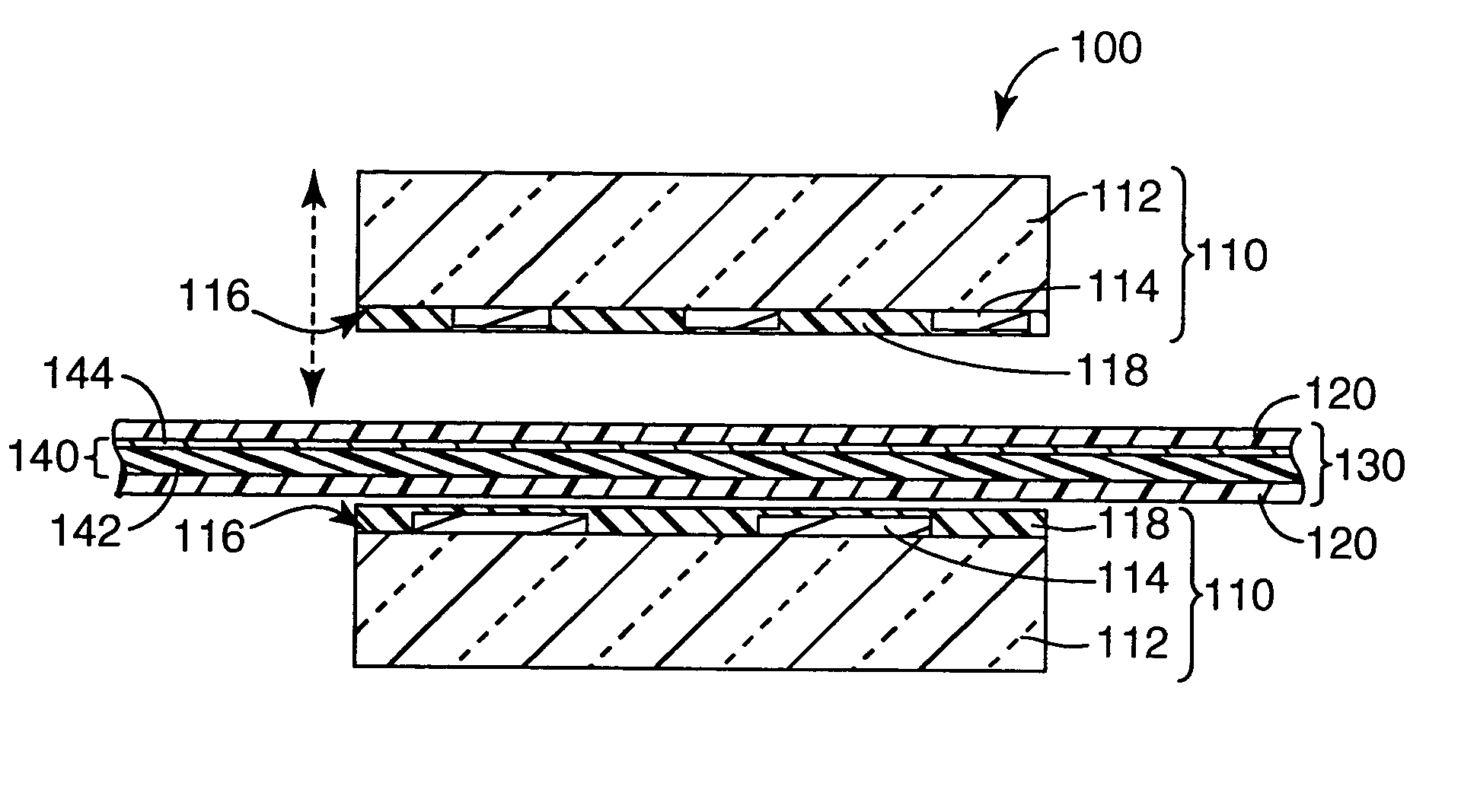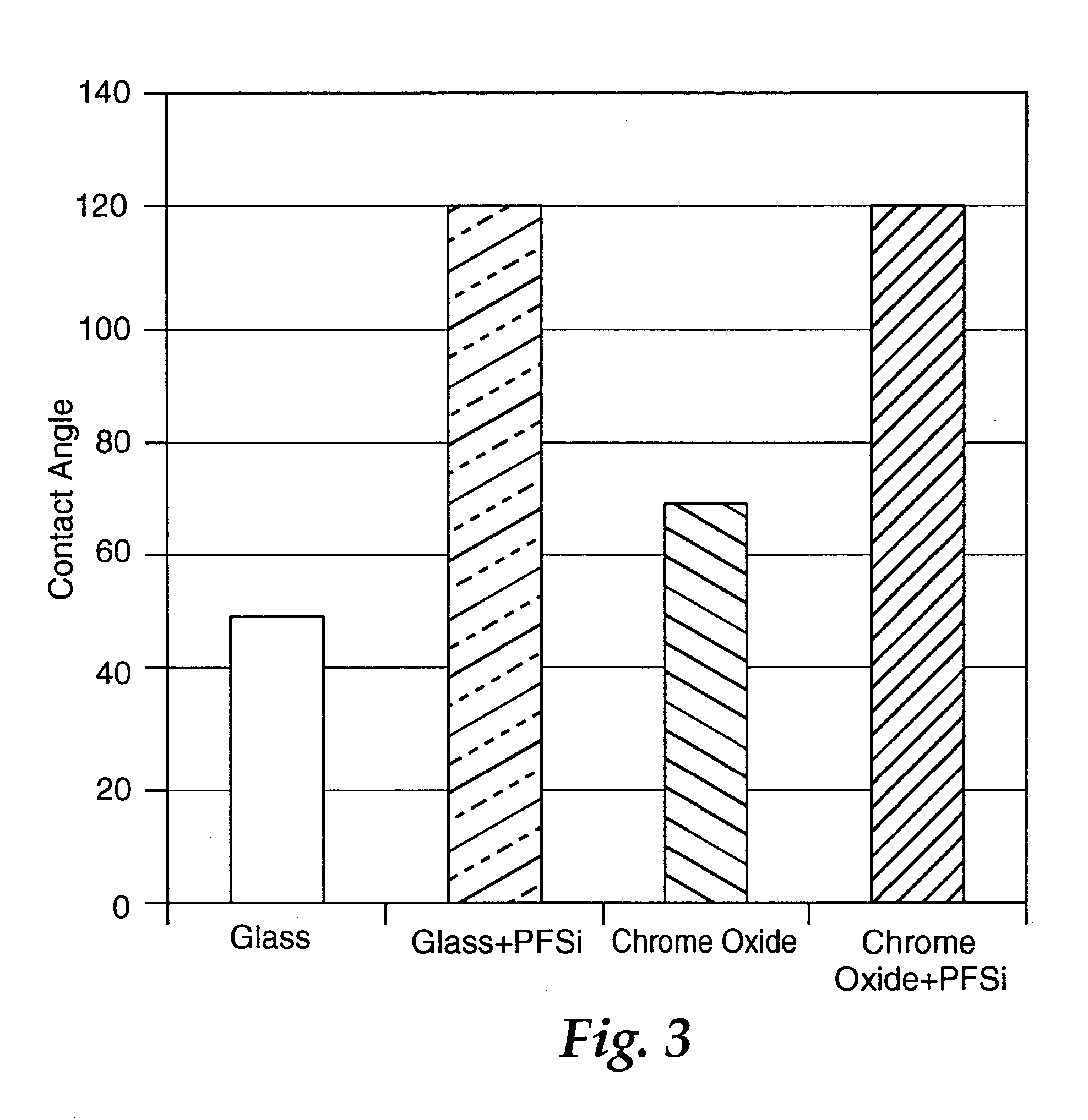Phototool coating
a technology of phototools and coatings, applied in the field of contact printing, can solve the problems of affecting the throughput of the lithographic process, reducing the yield of products, and affecting so as to prolong the service life of phototools, and reduce the cost of production
- Summary
- Abstract
- Description
- Claims
- Application Information
AI Technical Summary
Benefits of technology
Problems solved by technology
Method used
Image
Examples
example 1
Perfluoropolyether silane, prepared as described in U. S. Pat. No. 6,277,485, Example 2 and column 13, lines 44-58, and poly(hexafluoropropyleneoxide-co-difluoromethylene oxide) alcohol ethoxylated phosphate(“perfluoropolyether phosphate”), available from Aldrich as Catalog # 45,767-1, were diluted into a hydrofluoroether solvent available under the trade name NOVEC Engineered Fluid HFE-7100 from 3M Company (St. Paul, Minn.). The concentrations were approximately 0.075 wt % ECC-1000 and 0.025 wt % perfluoropolyether phosphate.
A phototool comprising a glass substrate, pattern-coated with chromium oxide was cleaned by sonication in isopropyl alcohol, then 10 min exposure to air plasma using a Harrick (Ossining, N.Y.) PDC-3×G plasma cleaner / sterilizer. The phototool was then dip coated in the dilute solution. The dip coating withdrawal speed was 3.4 mm / sec using an automated dip coating apparatus. The phototool coating was cured at 120° C. for 30 min. (The dilute solution may, alter...
example 2
The procedure disclosed in J. Fluorine Chem. 1999, 95, 51 was followed for the preparation of the phosphate compound of Formula III. Pyrophosphoric acid (25.5 g, 0.14 mole, Aldrich) was placed in a 250 ml round bottom flask equipped with an overhead stirrer, water condenser, and thermocouple. The acid was heated to 60° C. at which point it was a viscous liquid. To this liquid was added in several two ml portions, C3F7O[CF(CF3)CF2O]nCF(CF3)CONHC2H4OH, (MN=1220, 50 g, 0.041 mole, n=3-10). This addition was slightly exothermic. After the addition was completed, the reaction mixture was held at 60° C. for two hours. Isopropyl acetate (35 ml) was added and the resulting solution then stirred with 150 ml of 2% aqueous HCl for four hours. The lower fluorochemical-containing phase was then separated and dissolved in about 300 ml methyl t-butyl ether (MTBE) and the ether solution then washed twice with an equal volume of 2N HCl solution. The MTBE solution was separated, dried over magnesium...
example 3
To make the compound of Formula I, diethyl (4-aminobenzyl)phosphonate (10 g, 0.041 mole, Aldrich), triethylamine (4.15 g, 0.041 mole) and methyl t-butyl ether (100 ml) were combined in a 250 ml round bottom flask equipped with an overhead stirrer and water condenser under nitrogen. To this mixture was added, dropwise over about 1.5 hours, C3F7O[CF(CF3)CF2O]nCF(CF3)COF, (MW=1017, 41.8 g, 0.041 mole). Near the end of the addition the solution became nearly homogeneous. After stirring for 16 hours at ambient temperature, the solution was diluted with additional MTBE and washed with about 5% aqeuous sodium bicarbonate and then once with 2N HCl. After drying over magnesium sulfate the solvent was removed by rotary evaporation. The amide carbonyl was seen at 1721.5 cm−1 in the infrared spectrum of the resulting product.
Without further purification, the phosphonate was dissolved in diethyl ether and bromotrimethylsilane (17.6 g, 0.115 mole, Aldrich) was added all at once. The solution w...
PUM
 Login to View More
Login to View More Abstract
Description
Claims
Application Information
 Login to View More
Login to View More - R&D
- Intellectual Property
- Life Sciences
- Materials
- Tech Scout
- Unparalleled Data Quality
- Higher Quality Content
- 60% Fewer Hallucinations
Browse by: Latest US Patents, China's latest patents, Technical Efficacy Thesaurus, Application Domain, Technology Topic, Popular Technical Reports.
© 2025 PatSnap. All rights reserved.Legal|Privacy policy|Modern Slavery Act Transparency Statement|Sitemap|About US| Contact US: help@patsnap.com



